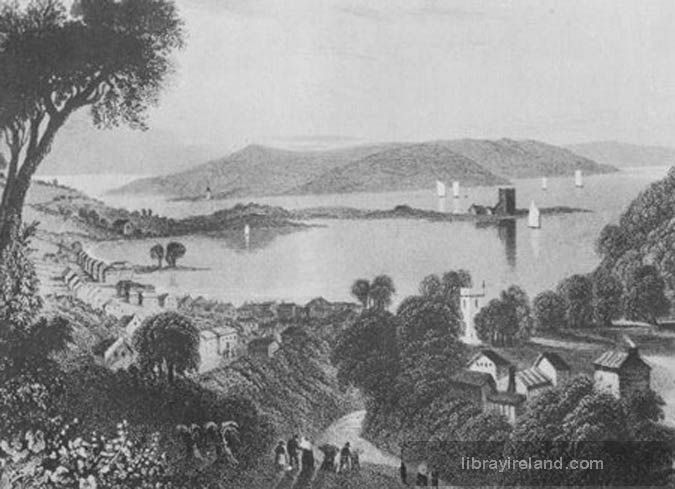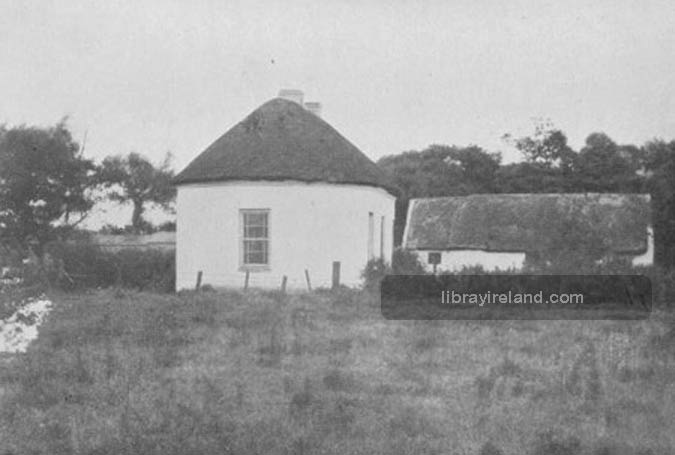Antrim - Story of Belfast
ONE can scarcely believe that the small, quiet town of Antrim once played a very important part in history. Like many other places, it counts its history back to the days of St. Patrick. He must have had an uncommonly busy time if he really founded all the churches and monasteries for which he is given credit. There is no doubt that there was an abbey in Antrim in very remote times. It is said to have been beside where the "Steeple" or round tower is, which is now one of the principal objects of interest about Antrim. In recent years some excavations were made in the vicinity of the tower, and the foundations of the ancient walls were discovered and a large quantity of human bones. Probably there was a graveyard beside it. The "Round Tower" of Antrim is considered to be one of the most perfect in Ireland, and it is certainly a very striking feature in the neighbourhood. As St. Patrick is said to have been the founder of most of our ancient religious houses, so the "Goban Saor" is credited with the building of many of the fortresses and round towers.
Legend tells that it was the Goban Saor who built the "Round Tower" at Antrim in the seventh century. It is not a matter of much importance now who built it, but whoever he was, he built, not for a brief lease of life, but for all time. He built his tower to stand for ages, and it has done so. It is a very perfect specimen of these curious structures that abound in Ireland. It is ninety-five feet high and fifty-three feet in circumference. It is divided into three storeys with loopholes for light and air. The door is twelve feet from the ground. The tower tapers at the top like a sugar loaf, and it was formerly covered with a granite cap, but in the year 1822 it was struck by lightning and was re-roofed. It stands—a strange monument of ancient history—in the centre of well kept grassy lawns, and the secret of why it is there remains a secret still. In the garden beside the tower there is a most curious mass of basalt with two cavities nineteen inches long, sixteen wide, and nine deep. Even in the driest season, they are filled with clear water.
The Parish Church was built in 1595, a small building with Gothic windows. There is a curious tombstone beside the Church which tells us that the colours of a once famous regiment lie buried there. They were cremated and interred in the year 1801. These are the exact words on the tombstone: on one side is "Sacred to the memory of Major James Gibson, D.b. Regt., who died the 28th of August, 1800, aged forty years," and on the other, "Here are interred the ashes of the late colours of the Dumbartonshire Regiment of Fencible Infantry, April 27th, 1801."
Millrow Presbyterian Church is one of the oldest in Ireland. It dates from 1619 and another near it from 1645.
Antrim Castle has a stately entrance and the Tudor gate flanked with two towers is unique. The Castle was built in 1662 by Sir John Clotworthy. He was rewarded by Charles II. with a peerage for services to himself. Antrim Castle is a great mansion set in the midst of lovely surroundings, but it is not endowed with the romance of its nearest neighbour, Shane's Castle. The Speaker's Chair and Mace that were used in the Irish Parliament in Dublin are carefully preserved in the Castle. Massereene means a "beautiful portion" and so it is indeed.
Antrim was for hundreds of years the scene of many conflicts and the town was burned and sacked over and over again. It was plundered and left desolate many times. In one of these terrible struggles it is said 3,000 people were killed. Antrim was one of the centres of the rising in 1798. There was a battle fought and a great many lives lost. The opposing forces met in the streets, and the inhabitants turned out in defence of their homes. Many women and children took refuge under the branches of the trees which overhung the river, and remained there in safety through the long hours of that dreadful day. Lord O'Neill was shot and died on the steps of the Market House. The marks of the bullets are still seen in the spire of the church, for it was in the street beside it the hottest fight took place. So many bullets were embedded in the oak door, that it was afterwards removed, and is still preserved in Antrim Castle. Henry Joy McCracken was the commander of the insurgents in Antrim. He was taken prisoner a few days after the battle, and his life came to an untimely end.
He was universally, regretted, but no efforts could avert his sentence. He was hanged at the Market House in High Street in Belfast, and was buried in Belfast, in the graveyard of St. George's Church. He had a fine character, and his unhappy death was deeply deplored by all who knew him.
At one time, there were forty-eight religious establishments in County Antrim alone, and an immense number of ancient fortresses and raths. Interesting remains are still to be seen of the old castles at Greencastle, Olderfleet, Castle Chichester, Red Bay, Castle of Court Martin, Glenville, Dunluce, Dunseverick, Kenbane, Doonaninny, Castle Cary, Bruce's Castle, Castle Upton, Lissanoure, Castle Robin and Portmore. It is impossible to even name them all, but we cannot conclude without mentioning the ruins beside the old Church at Kilroot, where Dean Swift was incumbent for two years. The graveyard is in a disgraceful condition, and the baptismal font is lying in the long grass, totally uncared-for. The rectory where he lived in the year 1695 is beside Kilroot station and is still inhabited.


